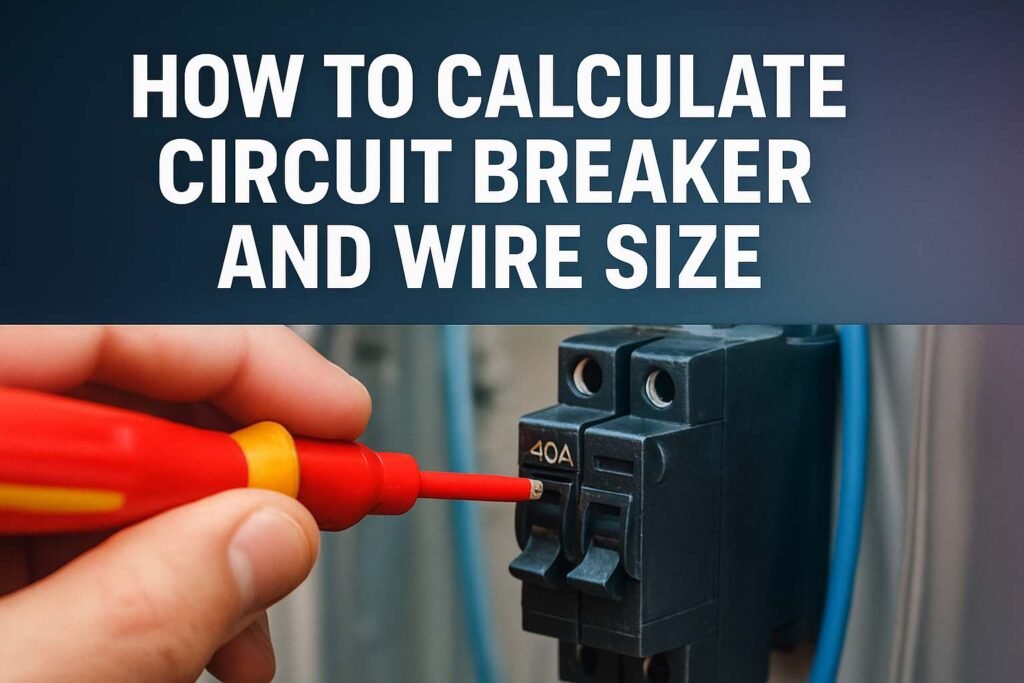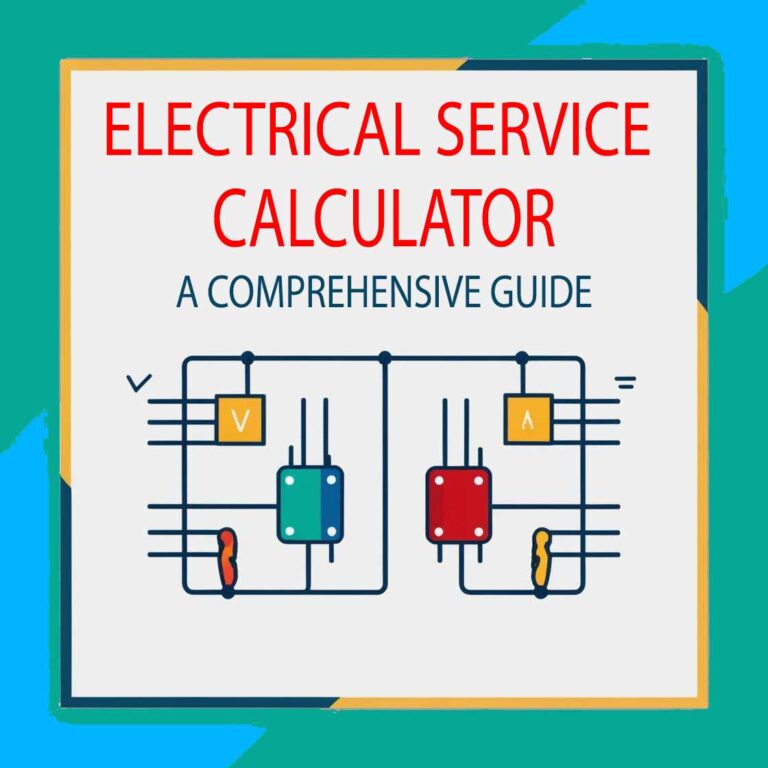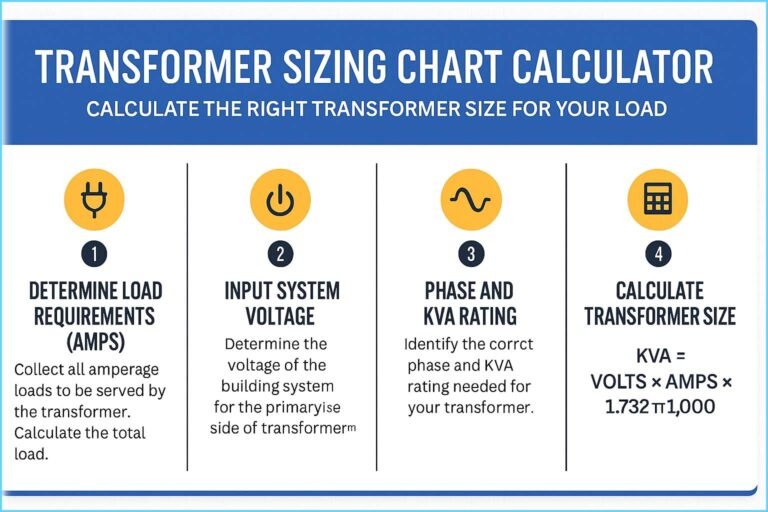How to Calculate Circuit Breaker and Wire Size: Best Guide
When planning an electrical installation, one of the most important steps is to select the correct circuit breaker and wire size. Using the wrong wire gauge or breaker rating can cause overheating, fire hazards, and poor system performance. Electricians, engineers, and even DIY homeowners must understand the fundamentals of electrical load calculation to ensure safety and efficiency.
Choosing the right breaker and conductor depends on load current, system voltage, conductor material, and installation method. If you want a quick estimation tool, you can also use a sub panel wire size calculator or an electrical service calculator to simplify the process.
Table of Contents
Table of Contents

Before diving into formulas and tables, let’s understand the relationship between current, wire gauge, and breaker size. Circuit breakers are designed to protect wires from carrying more current than they are rated for. If the load exceeds the safe capacity, the breaker will trip to prevent damage. Wire size, on the other hand, determines how much current can flow without overheating. Both need to be matched carefully to avoid mismatches that can lead to unsafe conditions.
Another important factor is voltage drop. A wire that is too small for a long run may cause excessive voltage drop, reducing the efficiency of appliances and motors. This is why professional electricians calculate both breaker size and conductor size together instead of guessing. The correct selection also ensures compliance with the NEC (National Electrical Code) or IEC standards depending on your region.
Key Takeaways:
- Circuit breaker size should always match the ampacity of the wire.
- Wire size depends on load current, distance, and allowable voltage drop.
- Safety codes require considering continuous loads, conductor material, and installation conditions.
- Tools like a sub panel wire size calculator and electrical service calculator simplify the process.
Use our online tool Circuit Breaker Size Calculator: Best Tool for Engineers
Why Correct Circuit Breaker and Wire Size Matters
An oversized breaker can allow wires to overheat before tripping, leading to fire hazards. An undersized breaker can trip frequently even when the load is within safe limits. Similarly, undersized wires increase resistance, cause heat build-up, and waste energy. In commercial or residential systems, this may even damage motors, HVAC systems, or sensitive electronics. Choosing the right combination keeps the electrical system reliable, energy-efficient, and compliant with safety regulations.
How to Calculate Circuit Breaker and Wire Size
The calculation starts with finding the load current. Current is the deciding factor for both breaker and conductor. The formula is straightforward:
Load Current (I) = Power (W) ÷ Voltage (V)
For example, a 5000W load on a 240V system requires:
I = 5000 ÷ 240 = 20.8 Amps
Now that you know the current, you can size the breaker. According to NEC standards, continuous loads (running for more than 3 hours) should be sized at 125% of the load current.
Breaker Size = Load Current × 125%
In the above case:
Breaker Size = 20.8 × 1.25 = 26 Amps
So the nearest standard breaker is 30A.
Wire size is then chosen based on breaker rating and allowable ampacity. Wires are rated differently depending on whether they are copper or aluminum. Copper can carry more current compared to the same size aluminum conductor.
Use our online tool Free Electrical Wire Size Chart & Calculator – Find the Right Cable Every Time
Table: Common Wire Sizes and Ampacity (Copper)
| Wire Gauge (AWG) | Ampacity (Copper) | Typical Breaker Size |
|---|---|---|
| 14 AWG | 15 Amps | 15A |
| 12 AWG | 20 Amps | 20A |
| 10 AWG | 30 Amps | 30A |
| 8 AWG | 50 Amps | 50A |
| 6 AWG | 65 Amps | 60A |
| 4 AWG | 85 Amps | 80A |
| 2 AWG | 115 Amps | 100A |
| 1/0 AWG | 150 Amps | 150A |
These values assume copper wire at 75°C insulation rating. For aluminum, ampacity is usually about 20–25% lower.
Factors to Consider When Calculating
When learning how to calculate circuit breaker and wire size, several key considerations must be included beyond just current.
- Voltage Drop – NEC recommends keeping voltage drop under 3% for branch circuits. For long distances, a larger wire is required to reduce losses.
- Ambient Temperature – Higher temperatures reduce wire ampacity. Adjustments must be made if cables are installed in hot areas.
- Conduit Fill – Multiple wires in the same conduit can reduce current-carrying capacity due to mutual heating.
- Motor Loads – Motors have starting currents much higher than running current. Breaker sizing must account for inrush current.
- Continuous vs Non-continuous Load – Continuous loads need the 125% rule. Non-continuous can use 100%.
Use our online tool Single Phase vs Three Phase EV Charger Load Calculator
Example Calculation for a Residential Load
Suppose you are installing an air conditioning unit rated at 6000W on a 240V supply.
Step 1: Find Current
I = 6000 ÷ 240 = 25 Amps
Step 2: Breaker Size
Breaker = 25 × 1.25 = 31.25 Amps → Standard 35A breaker
Step 3: Wire Size
From the ampacity table, 10 AWG wire handles 30A, which is too small.
8 AWG copper supports 50A, so 8 AWG is the correct wire.
This shows why wire selection must always match the breaker.
Using 3-Phase Calculations
For three-phase circuits, current calculation changes slightly:
I = Power (W) ÷ (√3 × Voltage × Power Factor)
For example, a 10 kW motor on a 415V three-phase supply with 0.9 power factor:
I = 10000 ÷ (1.732 × 415 × 0.9) = 15.5 Amps
Applying the 125% rule:
Breaker = 15.5 × 1.25 = 19.4 Amps → 20A Breaker
Wire size is then selected based on 20A requirement.
Know more about How to Calculate Load for Multiple EV Chargers in Apartment Buildings
Table: Standard Breaker Ratings vs Wire Size (Copper)
| Breaker Rating | Recommended Wire (AWG) | Equivalent mm² |
|---|---|---|
| 15A | 14 AWG | 2.5 mm² |
| 20A | 12 AWG | 4.0 mm² |
| 30A | 10 AWG | 6.0 mm² |
| 40A | 8 AWG | 10 mm² |
| 60A | 6 AWG | 16 mm² |
| 100A | 2 AWG | 35 mm² |
| 150A | 1/0 AWG | 50 mm² |
These are general guidelines and must be adjusted for temperature, conduit fill, and voltage drop.
Practical Tips for Safe Selection
When deciding how to calculate circuit breaker and wire size, keep these points in mind:
- Never use a wire smaller than the breaker rating.
- Always check voltage drop for long runs.
- For aluminum conductors, use one size larger than copper.
- Check local electrical codes, as they may have stricter requirements.
- Consider future expansion; oversizing slightly can prevent costly rewiring later.
Use our online tool What Gauge Wire Do I Need? Free Online Calculator for Electricians & Homeowners
Conclusion
Understanding how to calculate circuit breaker and wire size is a vital skill for ensuring electrical safety and performance. The process involves calculating load current, applying the 125% rule for continuous loads, selecting the correct breaker, and matching it with a wire that has equal or higher ampacity. Consideration of factors like voltage drop, conductor material, and ambient temperature is equally important.
For quick and reliable results, you can always make use of a sub panel wire size calculator or an electrical service calculator to verify your manual calculations. Whether you are working on residential wiring or industrial panels, the right combination of breaker and wire guarantees safe and efficient power distribution.
Follow Us on Social:
Subscribe our Newsletter on Electrical Insights to get the latest updates in Electrical Engineering.
#CircuitBreakerSizing, #WireSizeCalculation, #ElectricalSafety, #HomeWiring, #LoadCalculation, #ElectricalDesign, #BreakerAndWireSizing, #DIYElectrical, #ElectricalEngineering, #PowerDistribution, #ElectricalWiringTips, #BreakerSizingGuide, #WireSizingMadeEasy, #ResidentialWiring, #ElectricalLoad





